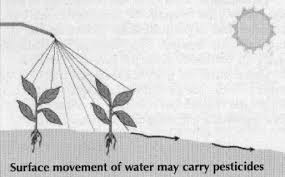Pesticide mobility may result in redistribution within the application site or movement of some amount of the pesticide off site.
Following the application of a pesticide, it may: (i) attach to soil particles, vegetation, or other surfaces and remain near the site of deposition, (ii) attach to soil particles and move with eroded soil in runoff or wind, (iii) dissolve in water and be taken up by plants, move in runoff, or leach, (iv) volatilize or erode from foliage or soil with wind and become airborne (Tyriaki and Temur, 2010).
Pesticide mobility is affected by its sorption, water solubility, vapour pressure, and other environmental and site characteristics including weather, topography, canopy and ground cover; and soil organic matter, texture and structure (Kerle etal., 2007).
Pesticide Properties Affecting Its Mobility
To reduce the risk of contaminating the groundwater, it is essential to understand the factors that control the mobility of pesticides in the soil.
The mobility of pesticides in the soil is not determined by a single property of the pesticide but controlled by a combination of properties including water solubility, absorptivity, volatility, and pesticide half-life.
The first two properties determine how much of the pesticide will be bound versus free, whereas the half-life relates to the persistence of the pesticide.
Water Solubility
Water solubility is a measurement of how much of a chemical will dissolve in water, and typically is expressed in parts per million (Hartzler, 2018). It is perhaps the single most important property influencing a pesticide’s movement with water.
When a pesticide enters soil, some of it will stick to soil particles, particularly organic matter, through a process called sorption and some will dissolve and mix with the water between soil particles, called “soil water.”

As more water enters the soil through rain or irrigation, the sorbed pesticide molecules may be detached from soil particles through a process called desorption. The solubility of a pesticide and its sorption on soil are inversely related, meaning that increased solubility results in less sorption.
The partition coefficient (Koc) is one of the most useful indices for quantifying pesticide sorption on soils. The Koc value is defined as the ratio of pesticide concentration in the sorbed-state (that is, bound to soil particles) and the solution-phase (that is, dissolved in the soil-water).
Thus, for a given amount of pesticide applied, the smaller the Koc value, the greater the concentration of pesticide in solution. Pesticides with small Koc values are more likely to be leached compared to those with large Koc values (Rao and Hornsby, 2001).
In other words, the higher the water solubility value, the more soluble the chemical. For example, a pesticide with a water-solubility value of 33,000 ppm at 27°C is much more water-soluble than a pesticide with a water-solubility of 33 ppm at 27°C, and it is more likely to leach.
Absorptivity
Absorptivity is the electrical attraction between a chemical compound and soil. Pesticides strongly adsorbed to soil particles usually remain in the root zone, where they can be absorbed by plants or degrade.
Weakly adsorbed pesticides move down through the soil profile with rain or irrigation water. The amount of adsorption depends upon a pesticide’s chemical properties, its concentration in the soil water, and on the soil type and its holding potential.
Volatility
Volatility is the tendency for a liquid or a solid to change into a gas. Volatility measures how quickly a pesticide evaporates in air. Highly volatile pesticides vaporize into the atmosphere, thus reducing the leaching potential.
Some pesticides, such as fumigants, must be volatile in order to move and provide uniform distribution through the soil profile. However, placing or sealing a pesticide in the soil reduces volatilization and increases leaching potential.
Read Also : Roles of Producers and Corporations in Waste Management
Pesticide Half-Life
The half-life of a pesticide describes the length of time it takes 50% of the pesticide to break down to secondary compounds.
For example, if one kilogram of a product with a half-life of 90 days is applied, we would expect 0.5 kg to remain 90 days after application.
After another 90 days, 0.25 kg should be left in the field. The half-life of a herbicide varies with soil characteristics and environment.
For example, the half- life of atrazine in Georgia (USA) on a soil with a pH of 6.8 was reported to be 39 days, whereas in Minnesota (USA) the half-life was 261 days on a soil with 7.9 pH.
It is important to ensure that half-lives were determined under similar conditions when comparing half-lives of different herbicides (Hartzler, 2018). In general, the longer the half-life, the greater the potential for pesticide movement.
A pesticide with a half- life greater than 21 days may persist long enough to leach or move with surface runoff before it degrades.

